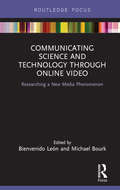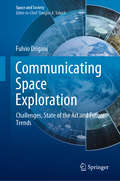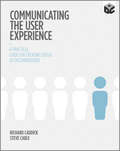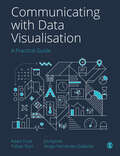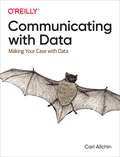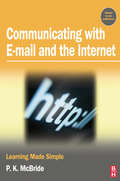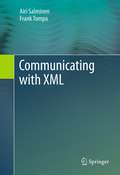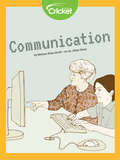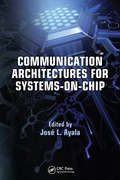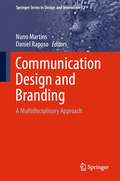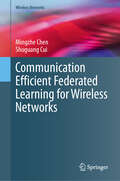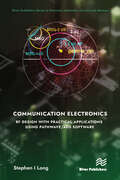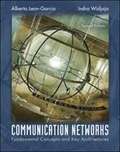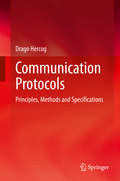- Table View
- List View
Communicating Embedded Systems: Software and Design (Wiley-iste Ser.)
by Claude Jard Olivier H. RouxThe increased complexity of embedded systems coupled with quick design cycles to accommodate faster time-to-market requires increased system design productivity that involves both model-based design and tool-supported methodologies. Formal methods are mathematically-based techniques and provide a clean framework in which to express requirements and models of the systems, taking into account discrete, stochastic and continuous (timed or hybrid) parameters with increasingly efficient tools. This book deals with these formal methods applied to communicating embedded systems by presenting the related industrial challenges and the issues of modeling, model-checking, diagnosis and control synthesis, and by describing the main associated automated tools.
Communicating Science Clearly: A Self-Help Guide For Students and Researchers
by Sharon Ann HolgateThis unique self-help guide equips undergraduates, postgraduate students, and early career researchers within the sciences with transferrable communication skills that they can adapt and refer back to as they progress through their careers. It provides practical guidance on how to best communicate science in a range of different settings. This book facilitates clear and concise communication in both academic scenarios and the workplace. It covers settings ranging from job interviews, through conference presentations, to explaining your research to the general public. It is illustrated with first-hand experiences, top tips, and "dos and don’ts" to demonstrate best practices. It will also be a valuable guide for established academics who would like a refresher or a guide to new avenues of science communication, such as podcasts. Key Features: Written by an award-winning professional science journalist and broadcaster with 25 years’ experience, including writing for national newspapers, devising and presenting programmes for BBC Radio 4, and being interviewed on radio, TV, video, and podcasts Covers science communication in a broad range of settings including peer-to-peer, to your manager, at job interviews, and during media appearances Includes advice from a range of experts who communicate professionally, including a radio producer, a TV presenter, actors and entertainers, and scientists Additional video material to accompany this book can be found here: https://www.youtube.com/playlist?list=PLLUWyRwmgFlW7_NrNupeuiJ86OxIWHZ6I. Sharon Ann Holgate is a freelance science writer and broadcaster. She has presented on BBC Radio 4 and the BBC World Service, and presented video podcasts for medical research charity the Myrovlytis Trust. She earned a D.Phil in physics from the University of Sussex, where she was a Visiting Fellow in Physics and Astronomy for nine years. Her articles have appeared in Science, Science Careers, New Scientist, The Times Higher Education Supplement, The Times Literary Supplement, Flipside, E&T, Focus, Physics World, Interactions, Materials World, Modern Astronomer, and Astronomy Now. She was also shortlisted for the radio programme category of the Association of British Science Writers' Awards in 2005, and for the Aventis Prizes for Science Books Junior Prize in 2003. Dr. Holgate was the recipient of the Institute of Physics 2022 William Thomson, Lord Kelvin Medal and Prize for communicating science to a wide variety of audiences and for positive representations of scientists from non-traditional backgrounds. She has also received the Institute of Physics Young Professional Physicist of the Year Award and a Merit Award in the Daily Telegraph Young Science Writer of the Year competition. She is the author of the undergraduate textbook Understanding Solid State Physics, which is currently in its second edition and used as a core text in universities around the world.
Communicating Science and Engineering Data in the Information Age
by Panel on Communicating National Science Foundation Science Engineering Information to Data UsersThe National Center for Science and Engineering Statistics (NCSES) of the National Science Foundation (NSF) communicates its science and engineering (S&E) information to data users in a very fluid environment that is undergoing modernization at a pace at which data producer dissemination practices, protocols, and technologies, on one hand, and user demands and capabilities, on the other, are changing faster than the agency has been able to accommodate. NCSES asked the Committee on National Statistics and the Computer Science and Telecommunications Board of the National Research Council to form a panel to review the NCSES communication and dissemination program that is concerned with the collection and distribution of information on science and engineering and to recommend future directions for the program. "Communicating Science and Engineering Data in the Information Age" includes recommendations to improve NCSES's dissemination program and improve data user engagement. This report includes recommendations such as NCSES's transition to a dissemination framework that emphasizes database management rather than data presentation, and that NCSES analyze the results of its initial online consumer survey and refine it over time. The implementation of the report's recommendations should be undertaken within an overall framework that accords priority to the basic quality of the data and the fundamentals of dissemination, then to significant enhancements that are achievable in the short term, while laying the groundwork for other long-term improvements.
Communicating Science and Technology Through Online Video: Researching a New Media Phenomenon (Routledge Focus on Communication Studies)
by Bienvenido León Michael BourkOnline video’s unique capacity to reach large audiences makes it a powerful tool to communicate science and technology to the general public. The outcome of the international research project "Videonline," this book provides a unique insight into the key elements of online science videos, such as narrative trends, production characteristics, and issues of scientific rigor. If offers various methodological approaches: a literature review, content analysis, and interviews and surveys of expert practitioners to provide information on how to maintain standards of rigour and technical quality in video production.
Communicating Space Exploration: Challenges, State of the Art and Future Trends (Space and Society)
by Fulvio DriganiThis book offers an enlightening analysis of the ways in which the communication of space explorations has evolved in response to political and social developments and the availability of new media and communication tools. Important challenges to effective communication are discussed, including the diversity of audiences, the risks associated with space missions, and continuing skepticism about the benefits of space research despite the many associated day-to-day applications. In addition, future trends in communication are examined with reference to likely trends in space exploration over the coming century. Besides space communication for the public, the need for targeted messaging to each group of stakeholders – decision makers, media, opinion leaders, the scientific community, and industry – is analyzed in detail. A series of case studies of particular space missions, both successful and unsuccessful, is presented to illustrate key issues. The book has significant implications for the communication of science in general and will be of interest to a wide audience, including space scientists, science communication professionals, people fascinated by exploration and discovery, stakeholders, and educators.
Communicating the User Experience
by Steve Cable Richard CaddickA clear and focused guide to creating useful user experience documentationAs web sites and applications become richer and more complex, the user experience (UX) becomes critical to their success. This indispensible and full-color book provides practical guidance on this growing field and shares valuable UX advice that you can put into practice immediately on your own projects. The authors examine why UX is gaining so much interest from web designers, graduates, and career changers and looks at the new UX tools and ideas that can help you do your job better. In addition, you'll benefit from the unique insight the authors provide from their experiences of working with some of the world's best-known companies, learning how to take ideas from business requirements, user research, and documentation to create and develop your UX vision.Explains how to create documentation that clearly communicates the vision for the UX design and the blueprint for how it's going to be developedProvides practical guidance that you can put to work right away on their own projectsLooks at the new UX tools and ideas that are born every day, aimed at helping you do your job better and more efficientlyCovers a variety of topics including user journeys, task models, funnel diagrams, content audits, sitemaps, wireframes, interactive prototypes, and moreCommunicating the User Experience is an ideal resource for getting started with creating UX documentation.
Communicating with Data Visualisation: A Practical Guide
by Adam Frost Tobias Sturt Jim Kynvin Sergio GallardoHow can you transform a spreadsheet of numbers into a clear, compelling story that your audience will want to pass on? This book is a step-by-step guide (honed through the authors′ Guardian masterclasses, workshops and seminars) to bringing data to life through visualisations, from static charts and maps to interactive infographics and motion graphics. Introducing a four-step framework to creating engaging and innovative visualisations, it helps you to: · Find the human stories in your datasets · Design a visual story that will resonate with your audience · Make a clear, persuasive visual that represents your data truthfully · Refine your work to ensure your visual expresses your story in the best possible way. This book also includes a portfolio of best-practice examples and annotated templates to help you choose the right visual for the right audience, and repurpose your work for different contexts.
Communicating with Data Visualisation: A Practical Guide
by Adam Frost Tobias Sturt Jim Kynvin Sergio GallardoHow can you transform a spreadsheet of numbers into a clear, compelling story that your audience will want to pass on? This book is a step-by-step guide (honed through the authors′ Guardian masterclasses, workshops and seminars) to bringing data to life through visualisations, from static charts and maps to interactive infographics and motion graphics. Introducing a four-step framework to creating engaging and innovative visualisations, it helps you to: · Find the human stories in your datasets · Design a visual story that will resonate with your audience · Make a clear, persuasive visual that represents your data truthfully · Refine your work to ensure your visual expresses your story in the best possible way. This book also includes a portfolio of best-practice examples and annotated templates to help you choose the right visual for the right audience, and repurpose your work for different contexts.
Communicating with Data: Making Your Case With Data
by Carl AllchinData is a fantastic raw resource for powering change in an organization, but all too often the people working in those organizations don't have the necessary skills to communicate with data effectively. With this practical book, subject matter experts will learn ways to develop strong, persuasive points when presenting data to different groups in their organizations.Author Carl Allchin shows anyone how to find data sources and develop data analytics, and teaches those with more data expertise how to visualize data to convey findings to key business leaders more effectively. Once both your business and data experts possess the skills to work with data and interpret its significance, you can deal with questions and challenges in departments across your organization.Learn the fundamental data skills required to work with dataUse data visualization to influence change in your organizationLearn how to apply data techniques to effectively work with data end to endUnderstand how to communicate data points clearly and persuasivelyAppreciate why different stakeholders often have divergent needs and viewsCreate a playbook for using data with different departments
Communicating with Email and the Internet
by P K McBrideThis handy textbook covers all you will need to know to learn to communicate using email and the internet. Learning Made Simple books give readers skills without frills. They are matched to the main qualifications, in this case ECDL, ICDL and CLAIT, and written by experienced teachers and authors to make often tricky subjects simple to learn. Every book is designed carefully to provide bite-sized lessons matched to learners' needs. Using full colour throughout, and written by leading teachers and writers, Learning Made Simple books help readers learn new skills and develop their talents. Whether studying at college, training at work, or reading at home, aiming for a qualification or simply getting up to speed, Learning Made Simple books give readers the advantage of easy, well-organised training materials in a handy volume with two or four-page sections for each topic for ease of use.
Communicating with XML
by Airi Salminen Frank TompaThis book provides extensive insight into the possibilities and challenges of XML in building new information management solutions in networked organizations. After a brief introduction to Web communication features and XML fundamentals, the book examines the benefits of adopting XML and illustrates various types of XML use: XML in document management; XML for data-centric and multimedia components; XML as a format for metadata, including metadata for the Semantic Web; and XML in support of data interchange between software applications and among organizations. The challenges of adopting XML in large-scale information management are also discussed. In addition, applications across a broad spectrum are examined and numerous case studies pertaining to the adoption of XML are presented. The book is particularly suitable for courses offered in Information Studies, Information Systems, or Information Technology. It also serves as an excellent practical guide for professionals in information management and provides important support material for courses in Computer Science and in Business.
Communicating with the World: Interaction between Chinese and International Media
by Liu LihuaThis book analyses the creation and dissemination of discourse in China while examining how its media and the people interact and communicate with the rest of the world. It explores the interplay between language, meanings, social practices, culture and politics in the processes of discourse generation. The book critically studies intercultural communication and Chinese discourse models at the national, institutional and individual levels and the different modes of interaction between China and the world. With the help of several case studies the book analyses reports from the People’s Daily, interpersonal meaning in promotional videos and advertisements in China, rhetoric in the editorials of China Daily and the representation by international media like The Associated Press and The New York Times to explore differences between Chinese and the Western media reporting the same event. It also looks at the complex models through which the Chinese people—both as individuals and as a collective—communicate with and gain an understanding of the rest of the world. Rich in empirical case studies, this book will be an essential read for scholars and researchers of Chinese Studies, communication studies, media and cultural studies, international relations and political communication.
Communication
by Melissa Shaw-SmithRyan’s father is on a tour of duty with the National Guard. Everyone else in his family seems to have found ways to cope with his absence, but Ryan hasn’t! When his dad’s deployment is extended, Ryan has to find a way to stay in touch with him. A trip to the library may be just what he needs—both for communication with his dad, and finding his way to cope!
Communication Architectures for Systems-on-Chip (Embedded Systems)
by José L. AyalaA presentation of state-of-the-art approaches from an industrial applications perspective, Communication Architectures for Systems-on-Chip shows professionals, researchers, and students how to attack the problem of data communication in the manufacture of SoC architectures. With its lucid illustration of current trends and research improving the performance, quality, and reliability of transactions, this is an essential reference for anyone dealing with communication mechanisms for embedded systems, systems-on-chip, and multiprocessor architectures—or trying to overcome existing limitations. Exploring architectures currently implemented in manufactured SoCs—and those being proposed—this book analyzes a wide range of applications, including: Well-established communication buses Less common networks-on-chip Modern technologies that include the use of carbon nanotubes (CNTs) Optical links used to speed up data transfer and boost both security and quality of service (QoS) The book’s contributors pay special attention to newer problems, including how to protect transactions of critical on-chip information (personal data, security keys, etc.) from an external attack. They examine mechanisms, revise communication protocols involved, and analyze overall impact on system performance.
Communication Complexity: and Applications
by Anup Rao Amir YehudayoffCommunication complexity is the mathematical study of scenarios where several parties need to communicate to achieve a common goal, a situation that naturally appears during computation. This introduction presents the most recent developments in an accessible form, providing the language to unify several disjoint research subareas. Written as a guide for a graduate course on communication complexity, it will interest a broad audience in computer science, from advanced undergraduates to researchers in areas ranging from theory to algorithm design to distributed computing. The first part presents basic theory in a clear and illustrative way, offering beginners an entry into the field. The second part describes applications including circuit complexity, proof complexity, streaming algorithms, extension complexity of polytopes, and distributed computing. Proofs throughout the text use ideas from a wide range of mathematics, including geometry, algebra, and probability. Each chapter contains numerous examples, figures, and exercises to aid understanding.
Communication Design and Branding: A Multidisciplinary Approach (Springer Series in Design and Innovation #32)
by Daniel Raposo Nuno MartinsThis book gathers new empirical findings fostering advances in the areas of communication design and branding, with a special emphasis of interdisciplinary approaches showing how to combine knowledge in those fields to improve businesses in a digital, global world. Gathering original, peer-reviewed contributions written by designers, computer scientists, marketer and product managers, this book provides both the communication and branding communities with a timely snapshot of current strategies and best-practices to improve different kinds of business through design. By highlighting current challenges, it is also intended to inspire and foster collaboration between different groups, in both university and industry.
Communication Efficient Federated Learning for Wireless Networks (Wireless Networks)
by Shuguang Cui Mingzhe ChenThis book provides a comprehensive study of Federated Learning (FL) over wireless networks. It consists of three main parts: (a) Fundamentals and preliminaries of FL, (b) analysis and optimization of FL over wireless networks, and (c) applications of wireless FL for Internet-of-Things systems. In particular, in the first part, the authors provide a detailed overview on widely-studied FL framework. In the second part of this book, the authors comprehensively discuss three key wireless techniques including wireless resource management, quantization, and over-the-air computation to support the deployment of FL over realistic wireless networks. It also presents several solutions based on optimization theory, graph theory and machine learning to optimize the performance of FL over wireless networks. In the third part of this book, the authors introduce the use of wireless FL algorithms for autonomous vehicle control and mobile edge computing optimization. Machine learning and data-driven approaches have recently received considerable attention as key enablers for next-generation intelligent networks. Currently, most existing learning solutions for wireless networks rely on centralizing the training and inference processes by uploading data generated at edge devices to data centers. However, such a centralized paradigm may lead to privacy leakage, violate the latency constraints of mobile applications, or may be infeasible due to limited bandwidth or power constraints of edge devices. To address these issues, distributing machine learning at the network edge provides a promising solution, where edge devices collaboratively train a shared model using real-time generated mobile data. The avoidance of data uploading to a central server not only helps preserve privacy but also reduces network traffic congestion as well as communication cost. Federated learning (FL) is one of most important distributed learning algorithms. In particular, FL enables devices to train a shared machine learning model while keeping data locally. However, in FL, training machine learning models requires communication between wireless devices and edge servers over wireless links. Therefore, wireless impairments such as noise, interference, and uncertainties among wireless channel states will significantly affect the training process and performance of FL. For example, transmission delay can significantly impact the convergence time of FL algorithms. In consequence, it is necessary to optimize wireless network performance for the implementation of FL algorithms.This book targets researchers and advanced level students in computer science and electrical engineering. Professionals working in signal processing and machine learning will also buy this book.
Communication Electronics: RF Design with Practical Applications using Pathwave/ADS Software (River Publishers Series in Electronic Materials, Circuits and Devices)
by Stephen I LongThis text/reference develops practical intuition into the art of RF circuit design and introduces users to the widely used simulation tool, Pathwave ADS, from Keysight Technologies. By using project-oriented assignments, it builds a strong foundation and focuses on practical applications illustrated by examples, simulation tutorials, and homework problems. Learning through doing has proven to be an effective preparatory tool for more advanced and complex applications, and this book is developed from the author’s lecture notes for a senior/graduate class at University of California Santa Barbara. The class had a significant lab component employing measurement techniques, board-level prototyping, and RFIC design. Falling somewhere between a traditional textbook and a practical handbook, it focuses mainly on analog RF analysis and design and circuit simulation techniques.
Communication Networks
by R. Srikant Lei YingProvides a modern mathematical approach to the design of communication networks for graduate students, blending control, optimization, and stochastic network theories. A broad range of performance analysis tools are discussed, including important advanced topics that have been made accessible to students for the first time. Taking a top-down approach to network protocol design, the authors begin with the deterministic model and progress to more sophisticated models. Network algorithms and protocols are tied closely to the theory, illustrating the practical engineering applications of each topic. The background behind the mathematical analyses is given before the formal proofs and is supported by worked examples, enabling students to understand the big picture before going into the detailed theory. End-of-chapter problems cover a range of difficulties, with complex problems broken into several parts, and hints to many problems are provided to guide students. Full solutions are available online for instructors.
Communication Networks for Smart Grids: Making Smart Grid Real (Computer Communications and Networks)
by Marina Thottan Kenneth C. Budka Jayant G. DeshpandeThis book presents an application-centric approach to the development of smart grid communication architecture. The coverage includes in-depth reviews of such cutting-edge applications as advanced metering infrastructure, distribution automation, demand response and synchrophasors. Features: examines a range of exciting utility applications made possible through smart grid evolution; describes the core-edge network architecture for smart grids, introducing the concept of WANs and FANs; explains how the network design paradigm for smart grids differs from that for more established data networks, and discusses network security in smart grids; provides an overview of communication network technologies for WANs and FANs, covering OPGW, PLC, and LTE and MPLS technology; investigates secure data-centric data management and data analytics for smart grids; discusses the transformation of a network from conventional modes of utility operation to an integrated network based on the smart grid architecture framework.
Communication Networks: Fundamental Concepts and Key Architectures (Second Edition)
by Alberto Leon-Garcia Indra WidjajaThis work is designed for introductory one-semester or one-year courses in communications networks in upper-level undergraduate programmes. The Big Picture is presented with a discussion of network-based applications and services such as the WWW, e-mail and home video entertainment. The essential functions in the operation of a network are discussed, and examples are given that motivate the notion of layering, and the OSI Reference model. Exposing students to the big picture should help them learn and apply the information more readily. Network performance is introduced as an integral part of network design and operation.
Communication Patterns: A Guide for Developers and Architects
by Jacqui ReadHaving a great idea or design is not enough to make your software project succeed. If you want stakeholders to buy into your design and teams to collaborate and contribute to the vision, you also need to communicate effectively. In this practical book, author Jacqui Read shows you how to successfully present your architecture and get stakeholders to jump on board.Misunderstanding and lack of buy-in leads to increasing costs, unmet requirements, and an architecture that is not what you intended. Through constructive examples and patterns, this book shows you how to create documentation and diagrams that actually get the message across to the different audiences you'll face.This book shows you how to:Design diagrams and documentation appropriate to your expected audience, intended message, and project stageCreate documentation and diagrams that are accessible to those with varying roles, needs, or disabilitiesMaster written, verbal, and nonverbal communication to succeed in technical settingsApply the communication patterns presented in this book in real-world projects and software designsCommunicate and collaborate with distributed teams to successfully design and document software and technical projects
Communication Principles for Data Science (Signals and Communication Technology)
by Changho SuhThis book introduces the basic principles underlying the design and analysis of the digital communication systems that have heralded the information revolution. One major goal of the book is to demonstrate the role of the digital communication principles in a wide variety of data science applications, including community detection, computational biology, speech recognition and machine learning. One defining feature of this book is to make an explicit connection between the communication principles and data science problems, as well as to succinctly deliver the “story” of how the communication principles play a role for trending data science applications. All the key “plots” involved in the story are coherently developed with the help of tightly coupled exercise problem sets, and the associated fundamentals are explored mostly from first principles. Another key feature is that it includes programming implementation of a variety of algorithms inspired by fundamentals, together with a brief tutorial of the used programming tools. The implementation is based on Python and TensorFlow. This book does not follow a traditional book-style organization, but is streamlined via a series of lecture notes that are intimately related, centered around coherent storylines and themes. It serves as a textbook mainly for a junior- or senior-level undergraduate course, yet is also suitable for a first-year graduate course. Readers benefit from having a good background in probability and random processes, and basic familiarity with Python. But the background can be supplemented by almost self-contained materials, as well as by numerous exercise problems intended for elaborating on non-trivial concepts. In addition, Part III for data science applications should provide motivation and insights to students and even professional scientists who are interested in the field.
Communication Protocol Engineering
by Miroslav PopovicAs embedded systems become more and more complex, so does the challenge of enabling fast and efficient communication between the various subsystems that make up a modern embedded system. Facing this challenge from a practical standpoint, Communication Protocol Engineering outlines a hands-on methodology for developing effective communication protocols for large-scale systems.A Complete RoadmapThis book brings together the leading methods and techniques developed from state-of-the-art methodologies for protocol engineering, from specification and description methods to cleanroom engineering and agile methods. Popovic leads you from conceptualization of requirements to analysis, design, implementation, testing, and verification. He covers the four main design languages: specifications and description language (SDL); message sequence charts (MSCs); tree and tabular combined notation (TTCN); and unified modeling language (UML).Practical Tools for Real SkillsFully illustrated with more than 150 figures, this guide also serves as a finite state machine (FSM) library programmer's reference manual. The author demonstrates how to build an FSM library, explains the components of such a library, and applies the principles to FSM library-based examples.Nowhere else are the fundamental principles of communication protocols so clearly and effectively applied to real systems development than in Communication Protocol Engineering. No matter in what stage of the process you find yourself, this is the ideal tool to make your systems successful.
Communication Protocols: Principles, Methods and Specifications
by Drago HercogThis book provides comprehensive coverage of the protocols of communication systems. The book is divided into four parts. Part I covers the basic concepts of system and protocol design and specification, overviews the models and languages for informal and formal specification of protocols, and describes the specification language SDL. In the second part, the basic notions and properties of communication protocols and protocol stacks are explained, including the treatment of the logical correctness and the performance of protocols. In the third part, many methods for message transfer, on which specific communication protocols are based, are explained and formally specified in the SDL language. The fourth part provides for short descriptions of some specific protocols, mainly used in IP networks, in order to acquaint a reader with the practical use of communication methods presented in the third part of the book. The book is relevant to researchers, academics, professionals and students in communications engineering.Provides comprehensive yet granular coverage of the protocols of communication systems Allows readers the ability to understand the formal specification of communication protocolsSpecifies communication methods and protocols in the specification language SDL, giving readers practical tools to venture on their own



